This was published 8 years ago
Solomon Islands, South Pacific: How culture and tradition created this South Pacific paradise
By Mal Chenu
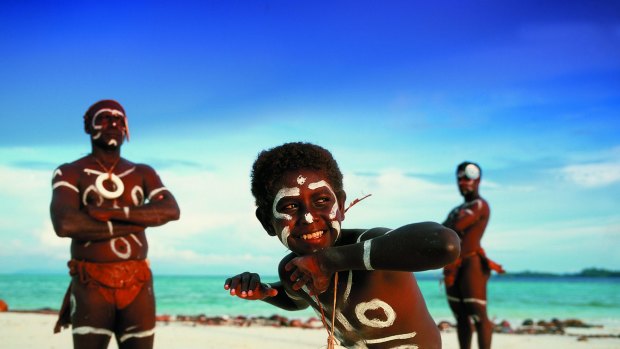
Traditional dancers with shell money at Vella Lavella Island, Western Province.
We can't understand a word but the soaring, sweet harmonies are inspirational, and devotional. The hymns bursting forth from this little open-air stone church in Babanga village are mostly in Pijin and the local dialect, one of about 70 in the Solomon Islands. Regardless, we are made to feel "welkam".
Out here in the Western Province – far from the grit of Honiara – there is a relaxed, unspoilt ambiance. On this hot and humid Sunday morning, the Babanga church fills slowly as the bell calls villagers to worship – even the good Lord is subject to "island time". Children file in first and begin singing without supervision but with plenty of passion. When the men arrive and add their powerful baritones the result is electric and the village is feeling the love today. Tourists can feel the love too with a stay in an adjacent Micronesian village, population 30. Two basic accommodation units are available and they come with two bedrooms, a bathroom, kitchenette and the get-away-from-it-all story of a lifetime.
The views on the 90-minute flight from Honiara to Gizo, the capital of Western Province, are extraordinary and a window seat is a must. Hundreds of sand-fringed islands surrounded by azure water and green lagoons pass below in a uniquely spectacular panorama.
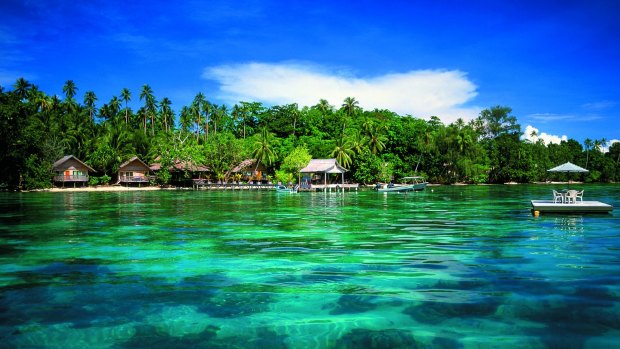
Sanbis Resort, Solomon Islands.
The main street of Gizo is dominated by the Gizo Hotel, shops and a fresh produce market, where betel nuts seem to be the most popular item. A cultural staple, betel nuts are widely enjoyed and provide a mild euphoric sensation when chewed, which is easy to observe as the ensuing smiles are lit bright red by the juice.
We are staying at Fatboys Resort on Mbabanga Island, a 10-minute boat ride from Gizo and not far from the village church. The name comes from the Charles Dickens' character Joe the fat boy in The Pickwick Papers. Joe ate and relaxed a lot, and while you can take that hint if you want, there are wondrous adventures to be had here too. But that can wait – it would be impolite to refuse the fresh lobster lunch, as it won't be on the menu again until dinner.
The centrepiece at Fatboys is the overwater bar and restaurant, where the SolBrew beers are cold, the meals delicious and the non-stop show of fish swimming beneath – including their three "pet" black tip reef sharks – mesmerising. They feed their pets regularly and the sharks attack the fish offcuts with speed and ferocity. We are then assured it's perfectly safe to snorkel.
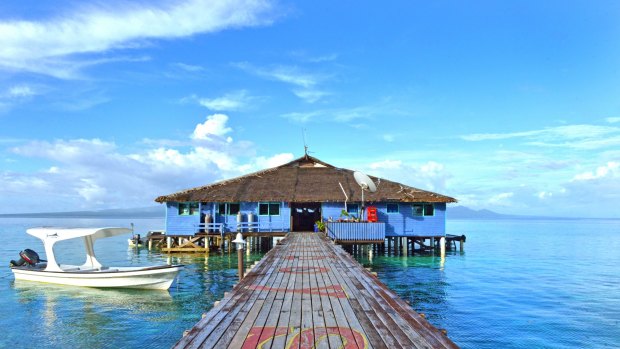
Fatboys resort is the pick of the bunch.Credit: Solomon Islands Visitors Bureau
Fatboys has five bungalows and the "honeymoon suite" on the shoreline is the pick of an excellent bunch. The entire front wall of the bungalow is open to the lagoon, which laps up under a spacious, sun-soaked balcony. A few hundred metres off shore is tiny Kennedy Island, to which JFK swam after his PT boat was sliced in half by the Japanese destroyer Amagiri during World War II. Beyond that are more coral cays and the volcano-dominated Kolombangara island, a birdwatching, rainforest, and mountain hiking Nirvana with eco-lodge accommodation.
Chilled-out Sanbis Resort is on the same island as Fatboys and offers six bungalows, each with an en suite and a private strip of beach. Sanbis does not cater for children under 12 but it does have an in-house dive centre, pizza oven and the very kitschy SB Bar.
Tours and day trips from Fatboys, Sanbis or Gizo are many and varied and the resorts and the Solomon Islands Visitors Bureau will be happy to hook you up. The bureau is trying to build a tourism industry based on surfing, honeymoons, bird watching, war history, fishing, diving and traditional culture. This last is the most pressing as maintaining traditional culture and customs, known as "kastom", is very important to the government and the villagers.
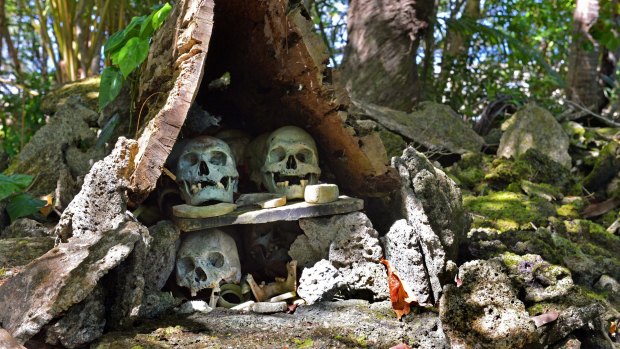
The remains of former chiefs and vanquished enemies at Skull Island.
The bureau's Stella Lucas is promoting this nascent cultural tourism in the hope that income generated will engender pride and maintain traditional skills.
"Essentially we are doing this for the children," Lucas says. "We are planning a controlled growth from 25,000 to 32,000 visitors per annum but we want to retain our identity and stay eco and boutique. We are looking to build on our own strengths rather than compete with other South Pacific nations."
Life here is very much centred on family and village but education is not free. Lucas says: "Bring a visitor, educate a child."
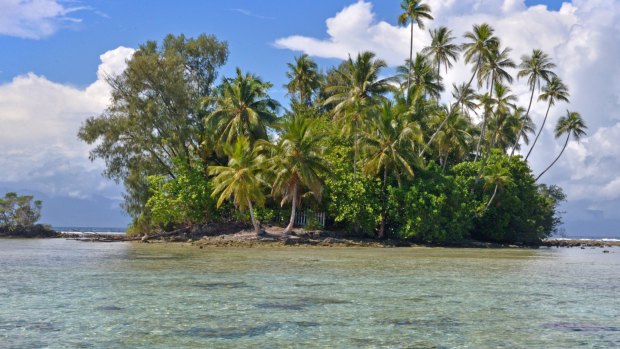
Skull Island.
Lucas has recently established tours to two Western Province villages – Boeboe SDA on Kohinggo Island and Marau Ugele community on Rendova Island, near Munda. Guided tours are preferred as it is considered impolite to just drop in to traditional villages unannounced but if you do, be sure to offer kastom fees (Aussie dollars are usually acceptable). Lucas escorts us to Boeboe, a community island Melanesian village of 386 people, 45 minutes by boat from Fatboys.
Haunting echoes of conch shells sound the call-to-arms as we approach the jetty. Child-warriors emerge, screaming and waving spears and banging shields, their black skin darkened further by mud. Larger, more intimidating warriors follow and the din escalates. The Chief eventually arrives, declares the threat over and the warriors retreat, taking their weapons and their priceless adolescent smiles with them.
The spears and screams are replaced by frangipani leis and coconut water as we are welcomed into Boeboe by Rocky, a retired policeman. Rocky is the perfect host and explains the processes as we see palm leaves woven into baskets, fans and roof thatching, stone oven cooking and wood and stone carving.
The handicrafts are unlike anything else you find in the South Pacific. Carved stone shell money and and wooden renderings of the God warrior Nguzu Nguzu inlaid with nautilus shell are particularly striking. Nguzu Nguzu is usually portrayed as a bust with a large head, protruding jaw and circular ear ornaments with small arms that clutch a head (for war) or a bird (for peace) beneath the jaw. We also see a skull house under construction. In headhunting days, which persisted into the early 20th century, this might have been intended for an opposing chief.
Finally, we are treated to a feast of fried reef fish, pana and kasaba (root crops), tapioca, eggplant and capsicum, cucumber, seaweed, pumpkin and dried bananas. Rocky tells us he has explained to the village that when tourists come they must be natural and do what they normally do. In a nod to this aspirational fusion of subsistence and commercialism, they will then "harvest the investment". We leave this happy, remote and real village hoping he is right.
FIVE MORE WESTERN PROVINCE HIGHLIGHTS
SURFING
Western Province has plenty of deserted breaks and the best conditions are between November and May. Paelongge is just minutes from Gizo and its long, shallow right-hander can get hollow in bigger swells. Zipolo Habu on remote Lola Island in the heart of Vona Vona Lagoon and nearby Skull Island also provide solid rides in the right conditions. Fatboys and Sanbis can lend you a board and take you to local swells Titiana and Naru by boat.
SKULL ISLAND
Beautiful Vona Vona Lagoon is the unlikely setting for the tiny Kundu Hite, or Skull Island. Skull shrines decorated with traditional shell money are filled with the skulls of vanquished enemies and ornate carved caskets containing the skulls of prominent chiefs from the headhunting days. This is a sacred place that should be visited with a qualified guide. Kastom fees should be paid and it is considered rude and bad karma to handle the skulls. No juggling or 'Alas, poor Yorick' impressions please.
DIVING
Western Province boasts the best diving in the Solomons. Danny Kennedy opened Dive Gizo in 1985 and knows the 18 excellent dive sites in the area like the back of his regulator. There are plenty of WWII wrecks to explore, as well as wall diving and coral gardens with some of the highest fish species counts in the world. Dive Gizo also has a well-stocked and fascinating gift shop knocking out shells and village arts and crafts. See divegizo.com
BIRDWATCHING, FISHING AND SNORKELLING
Whatever your pleasure, Western Province has an adventure to suit. Excursions are readily available and the locals know just where to go. The clean, clear waters of the region offer up sensational fishing and snorkelling conditions and twitchers will find unique, colourful and exotic birdlife.
DOLPHINS
Returning from one day trip, the lagoon comes alive as our boat is surrounded by a pod of more than 200 dolphins heading out for a spot of fishing. For 20 minutes we are part of the pod as the bottlenosed beauties jump and play and wave at us. It is a mind-etching, transcendent experience and one which our guide says is not uncommon.
TRIP NOTES
MORE INFORMATION
www.visitsolomons.com.sb; www.mysolomons.com.au
GETTING THERE
Solomon Airlines flies direct from Sydney and Brisbane to Honiara with connections to Gizo in Western Province. Boat transfers are included in hotel stays. See www.flysolomons.com; Phone 1300 894311
STAYING THERE
Fatboys and Sanbis are the best resorts in the Western Province and offer comfortable accommodation and access to various tours. See solomonislandsfatboys.com.au; sanbisresort.com
Eight-night packages combining a Western Province resort and two nights in Honiara at the Heritage Park Hotel (including flights, breakfast daily, transfers, tours and activities) start from $1890 a person twin-share ex Brisbane with up to $1000 bonus value. For bookings, packages and bonus deals for both Fatboys and Sanbis resorts, see www.mysolomons.com.au or call 1300 00 7656.
The writer travelled as a guest of Solomon Islands Visitor Bureau and Solomon Airlines.
Sign up for the Traveller Deals newsletter
Get exclusive travel deals delivered straight to your inbox. Sign up now.